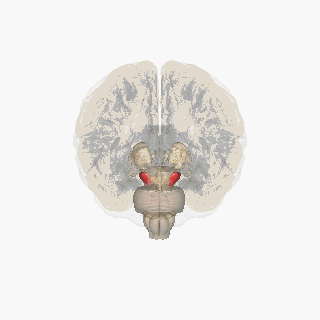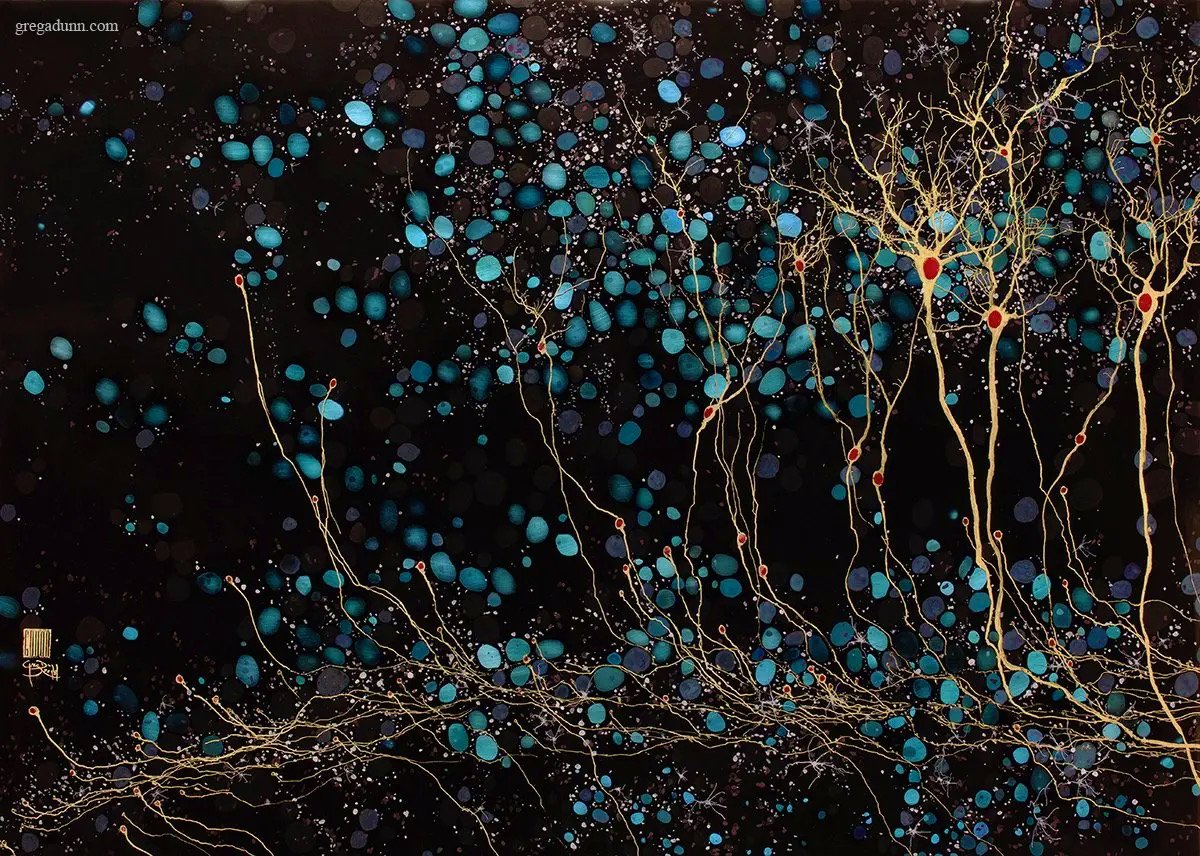(Melanie Boling, Harvard University, 2021)
Dopamine.
It’s our motivation to dominate our environment.
Winning.
Eating.
Sex.
Dopamine gives us access to food or partners.
When dopamine splashes over your brain, it’s a rush of pleasure.
Good grades.
Praise.
Dopamine just feels good.
The Human Brain.
(Greg Dunn Neuro Art- Brain and Neuroscience Fine Art Paintings, n.d.)
Dopamine pleasure differs from here & now pleasure, which is satisfaction.
A dopamine surge triggered by winning leaves us wanting more. It’s not enough to win. Dopamine wants anticipation. Winning is never enough for dopamine. Pursuit and victory are the surge, and more times than not, the urge for more.
Giving into the craving that dopamine provides does not guarantee your pleasure; simply, because wanting something versus liking something are two completely separate things.
Dopamine will only choose one.
The brain’s substantia niagra (Substantia Niagra, 2021).
This explains WHY human beings are willing to repeatedly put themselves into the extremes; it becomes a loop.
The brain LOVES loops, and this particular brain loop often times goes unnoticed because it’s become comfortable. Humans gravitate toward what is easy and requires no extra effort. As they say, checking all the boxes; but, at what cost?
When the human brain is engaged with this repeated cycle; to identify a goal in order to achieve their specific desire, one chemical in the brain takes control above all others, that is dopamine.
Becoming a master of your own homeostasis while mitigating allostatic load are the countermeasures to dopamine overload and the key to dopamine control.
(Neuroscientifically Challenged, 2015)
(Dopamine Pathways, 2013)
A principal mediator of the impact of stress on the brain and behavior are activation of the hypothalamic-pituitary-adrenal-axis, which results in widespread hormonal, neurochemical, and physiological alterations.
Inflammatory stimuli on brain and behavior have consistently reported evidence that inflammatory cytokines affect the basal ganglia and dopamine neurotransmission.
Findings have included inflammation-associated reductions in ventral striatal responses to reward, decreased dopamine and dopamine metabolites in cerebrospinal fluid, and decreased availability of striatal dopamine (Felger & Miller, 2012).
Dopamine response exhibits increased peripheral cytokines and other inflammatory markers, such as C-reactive protein or autoimmune and/or fibromyalgia response to stressors such as extreme environments (Felger & Miller, 2012).
(Toenders et al, 2021)
Could mastering Dopamine Control lead to neurogenesis in extreme environments as opposed to neurodegeneration?
Can personalized countermeasures mitigate potential negative variables within extreme environments?
Reinforcing our neural pathways over time through repeated exposure therapy would strengthen our own dopamine control, which could make space for wise-mind decisions through self-mastery. Thus, desensitizing our brain from the things which cause a negative neurophysiological response to stressful stimuli (Boling, 2021).
These physiological emotional-regulation tools will carry over into the everyday life of the practitioner by providing a renewed self-awareness, and the ability to maintain homeostasis, even in the direst of circumstances (Boling, 2021).
Brain Neurogenesis.
(Greg Dunn Neuropsychology Art- Brain and Neuroscience Fine Art Paintings, n.d.)
Coming Soon:
Dopamine in Extreme Environments: Dopamine Control, Part Two.
References:
Boling, Melanie. (2021). Melanie Noelani Boling. Imagery Beyond Borders. https://imagerybeyondborders.org
Boling, Melanie (2021). Reported results of Amazonian Entheogens for treatment of Complex-Post-Traumatic Stress Disorder (C-PTSD); Military Sexual Trauma (MST); and Traumatic Brain Injury (TBI) among U.S. Military Veterans and the benefits of application through small group indigenous shamanic ceremonies. The Amazon Rainforest: From Conservation to Climate Change-research. Harvard Summer School, August 9, 2021.
Castelli, V., Cimini, A., & Ferri, C. (2020). Cytokine Storm in COVID-19: “When You Come Out of the Storm, You Won’t Be the Same Person Who Walked in.” Frontiers in Immunology, 11, 2132. https://doi.org/10.3389/fimmu.2020.02132
Cools, R., & Roberts, A. C. (2004). The Role of Dopamine in Cognition: Insights from Neuropsychological Studies in Humans and Non-Human Primates. In S. Otani (Ed.), Prefrontal Cortex: From Synaptic Plasticity to Cognition (pp. 219–243). Springer US. https://doi.org/10.1007/1-4020-7949-4_10
Dopamine Pathways. (2013). Okinawa Institute of Science and Technology Graduate University OIST. Retrieved December 2, 2021, from https://www.oist.jp/news-center/photos/dopamine-pathways
Felger, J. C., & Miller, A. H. (2012). Cytokine effects on the basal ganglia and dopamine function: The subcortical source of inflammatory malaise. Frontiers in Neuroendocrinology, 33(3), 315—327. https://doi.org/10.1016/j.yfrne.2012.09.003
Felger, J. C. (2017). The Role of Dopamine in Inflammation-Associated Depression: Mechanisms and Therapeutic Implications. Current Topics in Behavioral Neurosciences, 31, 199–219. https://doi.org/10.1007/7854_2016_13
Foo, C., Lozada, A., Aljadeff, J., Li, Y., Wang, J. W., Slesinger, P. A., & Kleinfeld, D. (2021). Reinforcement learning links spontaneous cortical dopamine impulses to reward. Current Biology, 31(18), 4111-4119.e4. https://doi.org/10.1016/j.cub.2021.06.069
Frontiers | How Breath-Control Can Change Your Life: A Systematic Review on Psycho-Physiological Correlates of Slow Breathing | Human Neuroscience. (n.d.). Retrieved December 14, 2021, from https://www.frontiersin.org/articles/10.3389/fnhum.2018.00353/full
Garofalo, S., & di Pellegrino, G. (2015). Individual differences in the influence of task-irrelevant Pavlovian cues on human behavior. Frontiers in Behavioral Neuroscience, 9, 163. https://doi.org/10.3389/fnbeh.2015.00163
GREG DUNN NEURO ART- Brain and Neuroscience Fine Art Paintings. (n.d.). GREG DUNN NEURO ART. Retrieved December 15, 2021, from https://www.gregadunn.com/
Keltikangas-Järvinen, L., & Salo, J. (2009). Dopamine and serotonin systems modify environmental effects on human behavior: A review. Scandinavian Journal of Psychology, 50(6), 574–582. https://doi.org/10.1111/j.1467-9450.2009.00785
Lieberman, D., & Long, M. (2018). The Molecule of More: How a Single Chemical in Your Brain Drives Love, Sex, and Creativity--and Will Determine the Fate of the Human Race. Faculty Bookshelf. https://hsrc.himmelfarb.gwu.edu/books/249
MIND Foundation. (2019, December 22). Ayahuasca’s afterglow: Improved mindfulness & cognitive flexibility | Ashleigh Murphy-Beiner. https://www.youtube.com/watch?v=WADjcFNbhrg
Murphy-Beiner, A, and K Soar. “Ayahuasca’s ‘Afterglow’: Improved Mindfulness and Cognitive Flexibility in Ayahuasca Drinkers.” Psychopharmacology 237, no. 4 (April 2020): 1161–69.https://doi.org/10.1007/s00213-019-05445-3.
Peter, A. E., Sandeep, B. V., Rao, B. G., & Kalpana, V. L. (2021). Calming the Storm: Natural Immunosuppressants as Adjuvants to Target the Cytokine Storm in COVID-19. Frontiers in Pharmacology, 11, 2305. https://doi.org/10.3389/fphar.2020.583777
Plotkin, M. J. (2021). The Amazon: What everyone needs to know. Chapter 8 seminar. Lecture notes The Amazon Rainforest: From Conservation to Climate Change- seminar. Harvard Summer School. Delivered 3 August 2021.
Speaking of Psychology: The molecule of more—Dopamine. (n.d.). Retrieved December 14, 2021, from https://www.apa.org/research/action/speaking-of-psychology/dopamine
Spiny Neurons Receive Dopamine. (n.d.). Okinawa Institute of Science and Technology Graduate University OIST. Retrieved December 2, 2021, from https://www.oist.jp/news-center/photos/spiny-neurons-receive-dopamine
Substantia nigra. (2021). In Wikipedia. https://en.wikipedia.org/w/index.php?title=Substantia_nigra&oldid=1045490165
Sudevan, S., Muto, K., Higashitani, N., Hashizume, T., Higashibata, A., Ellwood, R. A., Deane, C. S., Rahman, M., Vanapalli, S. A., Etheridge, T., Szewczyk, N. J., & Higashitani, A. (2021). Loss of Contact in Space Alters Dopamine System in C. elegans (SSRN Scholarly Paper ID 3919931). Social Science Research Network. https://doi.org/10.2139/ssrn.3919931
Tang, L., Yin, Z., Hu, Y., & Mei, H. (2020). Controlling Cytokine Storm Is Vital in COVID-19. Frontiers in Immunology, 11, 3158. https://doi.org/10.3389/fimmu.2020.570993
Toenders, Y. J., Laskaris, L., Davey, C. G., Berk, M., Milaneschi, Y., Lamers, F., Penninx, B. W. J. H., & Schmaal, L. (2021). Inflammation and depression in young people: A systematic review and proposed inflammatory pathways. Molecular Psychiatry, 1–13. https://doi.org/10.1038/s41380-021-01306-8
About the author:
Melanie began attending Harvard in 2020 to complete a Graduate Certificate in Human Behavior with a specialization in Neuropsychology. Boling’s research has examined extreme environments and how they can have a potential negative impact on humans operating in the extreme environment. During her time at Harvard, she has built a mental wellness tool called a psychological field kit. Implementing these tools will allow an individual to thrive in an extreme environment while mitigating negative variables such as abnormal human behavior which can play a role in team degradation.
Melanie Boling, Extreme ICE Environments Neuroscientist, Boling Expeditionary Research Group; and Neuropsychology Graduate Student, Harvard University.



























